
In-Depth
Inagro’s research towards circular, sustainable aquaculture
June 19, 2023
By Stefan Teerlinck and Edson Panana, Inagro

Aquaculture research began at Inagro in 2008 in search of new sustainable and alternative ways to produce animal protein in Belgium, as the pig and chicken industry was becoming less profitable due to over production. To do this, Inagro built the aquaculture applied research centre for the development of freshwater fish production in recirculating aquaculture system (RAS) in Belgium.
Today, Inagro is a multi-disciplinary research centre located in Rumbeke-Beitem, Belgium with more than 50 years of experience and a current staff of more than 200 employees, performing applied research and transferring knowledge to the stakeholders within the agrifood chain.
The centre’s focus is how to make freshwater fish production in RAS more sustainable. In Europe, we believe fish production should go from a linear to a circular approach. This is to reduce the input of ingredients coming from non-sustainable origins and to reduce the pollution of our waters due to effluents from fish production.
Facility specs
This facility has a total surface area of 700m² for a total water volume of 160m³. It was designed to conduct pilot-scale research and to operate as a professional farm. Thus, all phases of fish production in RAS are present, from egg to market-size fish.
It has a broodstock chamber with controlled climate (20m³, today for pikeperch (Sander lucioperca)) and a hatchery system with twelve 225-litre tanks self-cleaning tanks for larval rearing and larval research.
It also has a juvenile system to produce 100,000 fingerlings (about 10g final body weight) and growout system for large feed and growth trails for all kind of freshwater fish up to two kg body weight (twenty 1.8m³ tanks).
The facility also has a fish storage system made up of four 8m³ tanks where our researchers can look to the performance of +2 kg fish, such as large pikeperch and salmon, in RAS. We also have a specially designed RAS for testing alternative new ingredients in aquafeeds (twelve 750-litre tanks) where fish growth performance and apparent digestibility of diets and ingredients can be tested.
All systems have computer-automated feeders and professional backups to secure constant production (emergency oxygen, electricity production, 24-hour watch). We use online probes for real-time monitoring of pH, dissolved oxygen, water temperature and conductivity on each tank. The systems have the flexibility to operate with groundwater, rainwater, tap water, or if needed, a mixture of them.
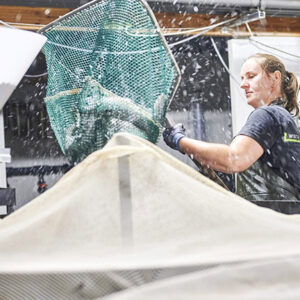
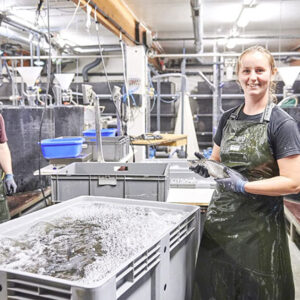
Research interests
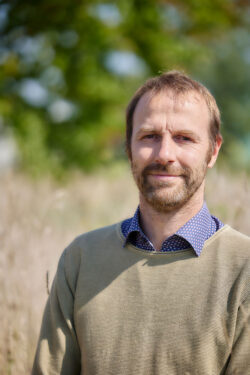
Stefan Teerlinck is head of research and insect production at Inagro. (Photo: Inagro)
Our first goal at Inagro was to develop the pikeperch (Sander lucioperca) production in RAS. Today, we control all the phases of the pikeperch production cycle from egg to one-kilogram-sized fish. In this frame, Inagro manages the European Percid Fish Culture (EPFC) group, a platform that gathers people from industry and research involved in percid fish. Within the EPFC group, courses are organized by Inagro for pikeperch producers from all over the world.
As Inagro has a wide range of applied research fields, we started to integrate on-site fish production with other available productions representing the Belgian food production sector, such as greenhouse vegetable production, arable crop production, insect production, duckweed production and many others.
Protein booster
Several research departments at Inagro make their productions circular and contribute to aquaculture.
Our researchers are currently working on these projects:
- Production of black soldier fly (Hermetia illucens), mealworm (Tenebrio molitor) and crickets (Acheta domesticus); these animals are champions in converting waste streams into proteins and fat.
- Development of single-cell protein production on methane coming from our in-house biogas installation where all kinds of waste streams are anaerobically fermented
- Duckweed (Lemma minor) production on manure and wastewater
- Production new local proteins, like soybean and peas
These potential raw materials are used in the aquaculture project, Protein Booster. We formulated an innovative trout feed for a local trout producer (B-trout), together with a local feed company (Lambers-Seghers) and an insect producer (Nusect). Our goal is to replace at least 50 per cent of the protein sources by Belgian circular proteins: insects, single cell, poultry products. During this project, several trials are conducted at Inagro in our growout system.
Starting with a screening trial where 5,000 trout of 100 grams are divided in 20 tanks. Five sustainable diets are compared against two control diets (traditional trout feed formulations). Out of the first trial, the best two experimental diets (better fish growth performance) are taken into the second trial where trout will grow for 20 weeks starting at one kilogram. In the third trial, we look at the performance of fish starting at three kilograms, and the effect of these sustainable diets in fillet quality traits.
Harnessing aquaponics
Inagro has a greenhouse (9,000m²) where vegetables are grown in a state-of-the-art production facility. Since 2014, Inagro has been conducting research on aquaponics as a solution in the integration of plant production and fish production.
In the INAPRO project and the Aquavlan2 project, the fish production was done with the rainwater coming from the greenhouse and the fish farm effluent water was used to maximally replace the rainwater and artificial nutrients in the greenhouse production.
While most of these experiments are performed using model fish such as tilapia and carp, Inagro opted for the use of effluent water coming from our pikeperch production. When quantity of the fish production is calculated towards the rainwater capture on the roof of the greenhouse, you should even be able to produce the fish next to the tomato production without extra water usage and no effluent to discharge from the fish culture.
For a tomato production of one hectare, this could result in 25 tons of fish next to the expected tomatoes, and this with up to 20 per cent reduction of artificial nutrient use in greenhouse. Not to mention that to some extent, we could see healthier plant growth in the gutters where the tomatoes got aquaculture effluent water.
At the same time, the aquaculture sludge was fed into our biogas installation resulting in combined heat and power used in the aquaculture and greenhouse facility closing the loop of productions even more.
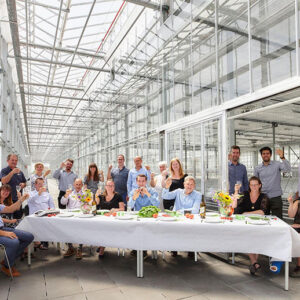
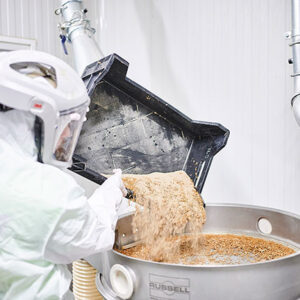
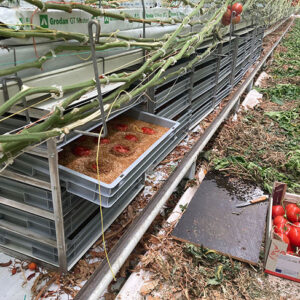
New methods
Inagro is also working on the combination of insect and vegetable production, with a new term we call this entomoponics.
Intensive vegetable production in greenhouses results in large amounts of waste (rutinary pinch out of the crops). Our current trial looks at the suitability of various byproducts from greenhouse farming as a food source for mealworms.
Mealworms need a moisture source in addition to a dry feed source (standard wheat bran). In the trial, the most common residual streams produced in greenhouses are tested, such as rejected cucumbers, tomatoes, strawberries and peppers, but also bell pepper leaves, green parts of the cucumber plant and even roots of lettuce grown on hydroponics.
Currently, limited differences in growth rates can be observed between these different moisture sources. None of the moisture sources lead to significantly higher mortality rates, from which we can conclude that they are not toxic.
In the near future, we are looking to close the circular loop in our production fish, insect and vegetable model. We aim for the co-creation amongst sectors. In this way, we would be able to couple production systems where the waste of one company can be utilized as a source of nutrients, energy or feed for another.
For example, rainwater can be first collected and used to produce fish in RAS. The effluent water, rich in nutrients, can be directed to our greenhouse and utilized for vegetable production. The byproduct of these crops can be used as feed for mealworm. This insect, rich in protein and fat, can be directly used as partial replacement of aquafeed or used to produce insect meal.
Finally, the sludge produced in the RAS (and to some extend it is the same for insect manure, called frass, can be potentially used in different processes such as: 1) mineralization via bacteriological processes to recover important nutrients, such as phosphorus, 2) used as bio- fertilizer for the grow of crops, 3) to produce energy in biogas reactor and 4) when possible by European law, an alternative ingredient for the insect production.
With our new ENOLL (European Network of Living Labs) approved “living lab circularity” and all the necessary pilots in situ like aquaculture and insect production, greenhouse, duckweed, biogas, Inagro develops methodologies – brainstorms, co-creation sessions, learning networks and workshops – to bring aquaculture to a future-proof circular level.
Print this page